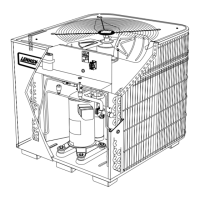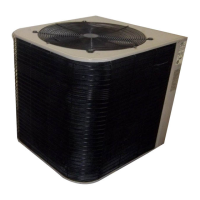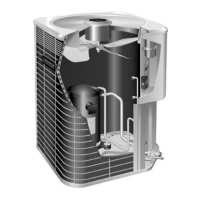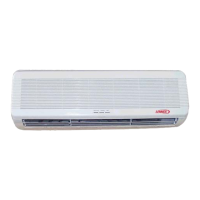Page 3
FIGURE 1
SCROLL FORM
FIGURE 2
STATIONARY SCROLL
ORBITING SCROLL
DISCHARGE
SUCTION
CROSS–SECTION OF SCROLLS
TIPS SEALED BY
DISCHARGE PRESSURE
DISCHARGE
PRESSURE
NOTE – During operation, the head of a scroll com-
pressor may be hot since it is in constant contact
with discharge gas.
The counterclockwise orbiting scroll draws gas into the
outer crescent shaped gas pocket created by the two
scrolls (figure 3 – 1). The centrifugal action of the orbit-
ing scroll seals off the flanks of the scrolls (figure 3 – 2).
As the orbiting motion continues, the gas is forced to-
ward the center of the scroll and the gas pocket be-
comes compressed (figure 3 – 3). When the com-
pressed gas reaches the center, it is discharged vertical-
ly into a chamber and discharge port in the top of the
compressor (figure 2). The discharge pressure forcing
down on the top scroll helps seal off the upper and low-
er edges (tips) of the scrolls (figure 2). During a single
orbit, several pockets of gas are compressed simulta-
neously providing smooth continuous compression.
The scroll compressor is tolerant to the effects of liquid
return. If liquid enters the scrolls, the orbiting scroll is
allowed to separate from the stationary scroll. The liq-
uid is worked toward the center of the scroll and is dis-
charged. If the compressor is replaced, conventional
Lennox cleanup practices must be used.
Due to its efficiency, the scroll compressor is capable
of drawing a much deeper vacuum than reciprocating
compressors. Deep vacuum operation can cause inter-
nal fusite arcing resulting in damaged internal parts
and will result in compressor failure. Never use a scroll
compressor for evacuating or “pumping–down” the
system. This type of damage can be detected and will
result in denial of warranty claims.
ORBITING
SCROLL
FIGURE 3
HOW A SCROLL WORKS
SUCTION
SUCTION
SUCTION
STATIONARY SCROLL
CRESCENT
SHAPED GAS
POCKET
HIGH
PRESSURE GAS
DISCHARGE
POCKET
FLANKS
SEALED BY
CENTRIFUGAL FORCE
12
34
SUCTION
INTERMEDIATE
PRESSURE
GAS
SUCTION
POCKET
MOVEMENT OF ORBIT
MOVEMENT OF ORBIT

